I get a little feed back from work. One thing people dont seem to understand how blogs work. Im there with ya still learning my self. But here the big thing it's like opening a book back wards. When you come in you either clicked on one thing on google and go strait there. Or you went to the main page. The main page is the last thing I wrote. So its the end of the book sort of speaking. So go to the bottom of the page see the words *old posts* click on that keep doing it til you get to the beginning. See the dates at the top. Watching them helps too. Now look at the posts from bottom to top because is layered that way.Think of it this way i rip the pages out of a book and i say to you lay them down in order starting with one,1 then 2 then 3 then 4. look at it see page one is at the bottom.
When i put up a post it always goes to the top of the page if i continue on the same subject and put up another post it goes to the top and the other one moves down. I know it crazy but all these hit tec. people smarter than us did it. So i hope you understand now. Ilove you
Also this thing over here to the left may help I just add it.
There are a lot of Pied Pipers in the world - ( media,Mis.O, government, fashion designers, celebs, Martha, and Doctor Oz). They are playing their pipes as the Rats follow behind. They lead us to where it profits or suits them the most. Granted some may have the intention of trying to help but the point is people follow in an army of fashion.Withoutchecking all the facts for them selves. People should have their own minds. I pray not to be a Rat but believe we are all rodents at least.
Read Old Post( In order)To New post

***READ old POST( in order) to new post
Monday, May 23, 2011
A few of 100 or more things that can go wrong, many we dont even count
Things That Can Go Wrong With the Endocrine System
Too much or too little of any hormone can be harmful to your body. For example, if the pituitary gland produces too much growth hormone, a teen may grow excessively tall. If it produces too little, a teen may be unusually short. Doctors can often treat problems with the endocrine system by controlling the production of hormones or replacing certain hormones with medication.Some endocrine problems that affect teens include:
Adrenal insufficiency. This condition occurs when the adrenal glands don't produce enough corticosteroids. The symptoms of adrenal insufficiency may include weakness, fatigue, abdominal pain, nausea, dehydration, and skin changes. Doctors treat adrenal insufficiency with medications to replace corticosteroid hormones.
Type 1 diabetes. When the pancreas fails to produce enough insulin, type 1 diabetes (pronounced: dy-uh-be-teez and previously known as juvenile diabetes) occurs. In kids and teens, type 1 diabetes is usually an autoimmune disorder, which means that some parts of the body's immune system attack and destroy the cells of the pancreas that produce insulin. To control their blood sugar levels and reduce the risk of developing diabetes problems, kids and teens with this condition need regular injections of insulin.
Type 2 diabetes. Unlike type 1 diabetes, in which the body can't produce normal amounts of insulin, in type 2 diabetes the body can't respond to insulin normally. Kids and teens with the condition tend to be overweight. Some kids and teens can control their blood sugar level with dietary changes, exercise, and oral medications, but many will need to take insulin injections like people with type 1 diabetes.
Growth hormone problems. Too much growth hormone in kids and teens who are still growing will make their bones and other body parts grow excessively. This rare condition (sometimes called gigantism) is usually caused by a pituitary tumor and can be treated by removing the tumor. The opposite can happen when a kid or teen has a pituitary glad that doesn't produce enough growth hormone. Doctors may treat these growth problems with medication.
Hyperthyroidism. Hyperthyroidism (pronounced: hy-per-thy-roy-dih-zum) is a condition in which the levels of thyroid hormones in the blood are very high. In kids and teens, the condition is usually caused by Graves' disease, an immune system problem that causes the thyroid gland to become very active. Doctors may treat hyperthyroidism with medications, surgery, or radiation treatments.
Hypothyroidism. Hypothyroidism (pronounced: hy-po-thy-roy-dih-zum) is a condition in which the levels of thyroid hormones in the blood are very low. Thyroid hormone deficiency slows body processes and may lead to fatigue, a slow heart rate, dry skin, weight gain, and constipation. Kids and teens with this condition may also grow more slowly and reach puberty at a later age. Hashimoto's thyroiditis is an immune system problem that often causes problems with the thyroid and blocks the production of thyroid hormone. Doctors often treat this problem with medication.
Precocious puberty. If the pituitary glands release hormones that stimulate the gonads to produce sex hormones too early, some kids may begin to go through puberty at a very young age. This condition is called precocious puberty. Kids and teens who are affected by precocious puberty can be treated with medication that will help them develop at a normal rate
What Does the Endocrine System Do?
What Does the Endocrine System Do?
Once a hormone is secreted, it travels from the endocrine gland that produced it through the bloodstream to the cells designed to receive its message. These cells are called target cells. Along the way to the target cells, special proteins bind to some of the hormones. These proteins act as carriers that control the amount of hormone that is available for the cells to use.The target cells have receptors that latch onto only specific hormones, and each hormone has its own receptor, so that each hormone will communicate only with specific target cells that have receptors for that hormone. When the hormone reaches its target cell, it locks onto the cell's specific receptors and these hormone-receptor combinations transmit chemical instructions to the inner workings of the cell.
When hormone levels reach a certain normal amount, the endocrine system helps the body to keep that level of hormone in the blood. For example, if the thyroid gland has secreted the right amount of thyroid hormones into the blood, the pituitary gland senses the normal levels of thyroid hormone in the bloodstream. Then the pituitary gland adjusts its release of thyrotropin, the hormone that stimulates the thyroid gland to produce thyroid hormones.
Another example of this process is parathyroid hormone. Parathyroid hormone increases the level of calcium in the blood. When the blood calcium level rises, the parathyroid glands sense the change and reduce their secretion of parathyroid hormone. This turnoff process is called a negative feedback system
more gland stuff
Hypothalamus
The hypothalamus (pronounced: hi-po-tha-luh-mus), a collection of specialized cells that is located in the lower central part of the brain, is the main link between the endocrine and nervous systems. Nerve cells in the hypothalamus control the pituitary gland by producing chemicals that either stimulate or suppress hormone secretions from the pituitary.Pituitary
Although it is no bigger than a pea, the pituitary (pronounced: puh-too-uh-ter-ee) gland, located at the base of the brain just beneath the hypothalamus, is considered the most important part of the endocrine system. It's often called the "master gland" because it makes hormones that control several other endocrine glands.The production and secretion of pituitary hormones can be influenced by factors such as emotions and changes in the seasons. To accomplish this, the hypothalamus provides information sensed by the brain (such as environmental temperature, light exposure patterns, and feelings) to the pituitary.
The tiny pituitary is divided into two parts: the anterior lobe and the posterior lobe. The anterior lobe regulates the activity of the thyroid, adrenals, and reproductive glands. The anterior lobe produces hormones such as:
- growth hormone, which stimulates the growth of bone and other body tissues and plays a role in the body's handling of nutrients and minerals
- prolactin (pronounced: pro-lak-tin), which activates milk production in women who are breastfeeding
- thyrotropin (pronounced: thy-ruh-tro-pin), which stimulates the thyroid gland to produce thyroid hormones
- corticotropin (pronounced: kor-tih-ko-tro-pin), which stimulates the adrenal gland to produce certain hormones
The posterior lobe of the pituitary releases antidiuretic (pronounced: an-ty-dy-uh-reh-tik) hormone, which helps control the balance of water in the body. The posterior lobe also produces oxytocin (pronounced: ahk-see-toe-sin), which triggers the contractions of the uterus in a woman having a baby
Pituitary, endocrine
What Is the Endocrine System?
Although we rarely think about the endocrine system, it influences almost every cell, organ, and function of our bodies. The endocrine system is instrumental in regulating mood, growth and development, tissue function, metabolism, and sexual function and reproductive processes.In general, the endocrine system is in charge of body processes that happen slowly, such as cell growth. Faster processes like
The foundations of the endocrine system are the hormones and glands. As the body's chemical messengers, hormones (pronounced: hor-moanz) transfer information and instructions from one set of cells to another. Many different hormones move through the bloodstream, but each type of
A gland is a group of cells that produces and secretes, or gives off, chemicals. A gland selects and removes materials from the blood, processes them, and secretes the
Some types of glands release their secretions in specific areas. For instance, exocrine (pronounced: ek-suh-krin) glands, such as the sweat and salivary glands, release secretions in the skin or inside the mouth. Endocrine glands, on the other hand, release more than 20 major hormones directly into the bloodstream where they can be transported to cells in other parts of the body.
The major glands that make up the human endocrine system include the:
- hypothalamus
- pituitary gland
- thyroid
- parathyroids
- adrenal glands
- pineal body
- reproductive glands (which include the ovaries and testes
pineal gland things
now remember it can be a few of each one of the things i'll be posting but not all of any of them. this gland has a lot of jobs and there is no tell what will come of it.
In guys the male gonads, or testes (pronounced: tes-teez), are located in the scrotum. They secrete hormones called androgens (pronounced: an-druh-junz), the most important of which is testosterone (pronounced: teh-stass-tuh-rone). These hormones tell a guy's body when it's time to make the changes associated with puberty, like penis and height growth, deepening voice, and growth in facial and pubic hair. Working with hormones from the pituitary gland, testosterone also tells a guy's body when it's time to produce sperm in the testes.
A girl's gonads, the ovaries (pronounced: oh-vuh-reez), are located in her pelvis. They produce eggs and secrete the female hormones estrogen (pronounced: es-truh-jen) and progesterone (pronounced: pro-jes-tuh-rone). Estrogen is involved when a girl begins to go through puberty. During puberty, a girl will experience breast growth, will begin to accumulate body fat around the hips and thighs, and will have a growth spurt. Estrogen and progesterone are also involved in the regulation of a girl's menstrual cycle. These hormones also play a role in pregnancy.
Although the endocrine glands are the body's main hormone producers, some other organs not in the endocrine system — such as the brain, heart, lungs, kidneys, liver, and skin — also produce and release hormones.
The pancreas (pronounced: pan-kree-us) is also part of the body's hormone-secreting system, even though it is also associated with the digestive system because it produces and secretes digestive enzymes. The pancreas produces (in addition to others) two important hormones, insulin (pronounced: in-suh-lin) and glucagon (pronounced: gloo-kuh-gawn). They work together to maintain a steady level of glucose, or sugar, in the blood and to keep the body supplied with fuel to produce and maintain stores of energy
Pineal
The pineal (pronounced: pih-nee-ul) body, also called the pineal gland, is located in the middle of the brain. It secretes melatonin (pronounced: meh-luh-toe-nin), a hormone that may help regulate when you sleep at night and when you wake in the morning.Reproductive Glands
The gonads are the main source of sex hormones. Most people don't realize it, but both guys and girls have gonads.In guys the male gonads, or testes (pronounced: tes-teez), are located in the scrotum. They secrete hormones called androgens (pronounced: an-druh-junz), the most important of which is testosterone (pronounced: teh-stass-tuh-rone). These hormones tell a guy's body when it's time to make the changes associated with puberty, like penis and height growth, deepening voice, and growth in facial and pubic hair. Working with hormones from the pituitary gland, testosterone also tells a guy's body when it's time to produce sperm in the testes.
A girl's gonads, the ovaries (pronounced: oh-vuh-reez), are located in her pelvis. They produce eggs and secrete the female hormones estrogen (pronounced: es-truh-jen) and progesterone (pronounced: pro-jes-tuh-rone). Estrogen is involved when a girl begins to go through puberty. During puberty, a girl will experience breast growth, will begin to accumulate body fat around the hips and thighs, and will have a growth spurt. Estrogen and progesterone are also involved in the regulation of a girl's menstrual cycle. These hormones also play a role in pregnancy.
Although the endocrine glands are the body's main hormone producers, some other organs not in the endocrine system — such as the brain, heart, lungs, kidneys, liver, and skin — also produce and release hormones.
The pancreas (pronounced: pan-kree-us) is also part of the body's hormone-secreting system, even though it is also associated with the digestive system because it produces and secretes digestive enzymes. The pancreas produces (in addition to others) two important hormones, insulin (pronounced: in-suh-lin) and glucagon (pronounced: gloo-kuh-gawn). They work together to maintain a steady level of glucose, or sugar, in the blood and to keep the body supplied with fuel to produce and maintain stores of energy
fluoride messes with the pineal gland
i feel i need to help everyone understand how things work so here we go;
step one the pineal gland where is it.
Third Eye - Pineal Gland

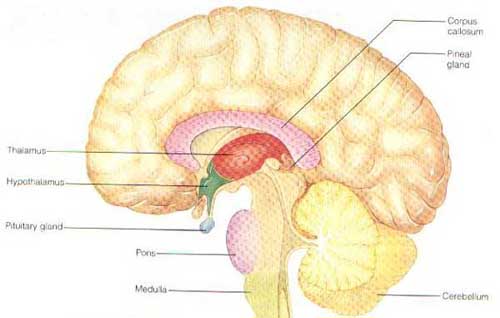
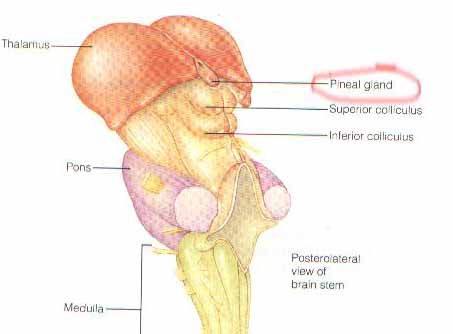
The pineal gland (also called the pineal body, epiphysis cerebri, epiphysis or the "third eye") is a small endocrine gland in the vertebrate brain. It produces

 2012 Enigma - Pine Cones - Pineal Gland Explained
2012 Enigma - Pine Cones - Pineal Gland Explained Pine Cone Pineal Gland
The pineal gland is located near to the center of the brain, between the two hemispheres, tucked in a groove where the two rounded thalamic bodies join. Unlike much of the rest of the brain, the pineal gland is not isolated from the
Today it is associated with the sixth chakra whose awakening is linked to prophecy and and increased psychic awareness as consciousness ascends.
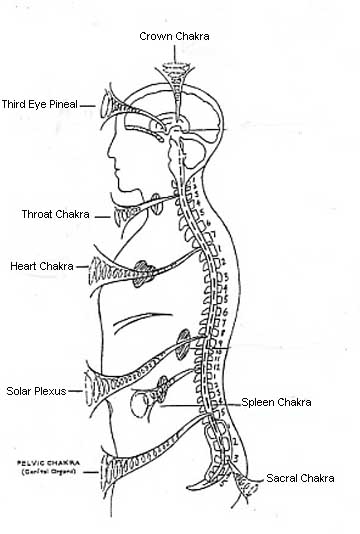
Chakras Spiraling Wheels or Cones of Energy
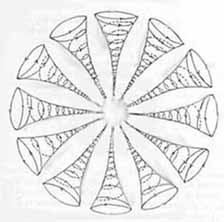 Spiraling Cones of Creation
Spiraling Cones of Creation12 Around
The pineal gland, or third eye, is located in the geometric center of the brain. This correlates to the location of the Great Pyramid in the center of the physical planet.

This pineal gland is activated by Light, and it controls the various bio-rhythms of the body. It works in harmony with the hypothalamus gland which directs the body's thirst, hunger, sexual desire and the biological clock that determines our aging process. When it awakens, one feels a pressure at the base of the brain.
While the physiological function of the pineal gland has been unknown until recent times, mystical traditions and esoteric schools have long known this area in the middle of the brain to be the connecting link between the physical and spiritual worlds. Considered the most powerful and highest source of ethereal energy available to humans, the pineal gland has always been important in initiating supernatural powers. Development of psychic talents has been closely associated with this organ of higher vision.
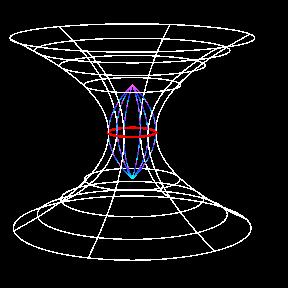
sees beyond Space-Time into Time-Space.
To activate the 'third eye' is to raise one's frequency and moving into higher consciousness - all is a consciousness experience perceived through the Eye of Time or Third Eye. Meditation, Visualization Yoga, and all forms of Out of Body travel, open the Third Eye and allow you to 'see' beyond the physical. As you practice, you will get it faster and more frequently. Your psychic abilities will increase as well as your dream time messages. You may first begin with your eyes closed, but as you practice, you will be able to open your third eye by focusing your attention and receiving messages with your physical eyes open. Planetary vibration/frequency is accelerating exponentially, allowing souls to peer into other realms far more easily than in the past. Frequency will continue to rise until consciousness evolves out of the physical in the next few years.

Kundalini
The pineal gland corresponds with divine thought after being touched by the vibrating light of Kundalini. starts its ascent towards the head center after responding to the vibrations from the 'light in the head.' The light is located at the top of the sutratma, or 'soul thread', which passes down from the highest plane of our being into the physical vehicle.
More fluoridation stuff
(NaturalNews) As a result of a year-long public outcry against water fluoridation in Austin, TX, the City Council held its second public meeting on the issue May 18, which attracted a standing-room only crowd.
Water fluoridation is a policy endorsed by numerous globalhealth organizations , most notably the American Dental Association and the Centers for Disease Control and Prevention. Controversy surrounding the practice has grown in recent years, however, as an increasing number of scientists and health professionals argue that fluoride in drinking water causes many negative health effects, especially when looked at beyond dental health to the impact on the whole body. (http://impactnews.com/southwest-aus...)
Areas in the U.S. and Canada, most recently Calgary with 1.1 million people, have already stopped fluoridation and U.S. cities such as Austin, Denver, CO and Boulder, CO, which are considering the fluoridation issue currently, may follow suit. This could cause a domino effect across North America and bring water fluoridation to a halt permanently, according to Fluoride Action Network Executive Director Dr. Paul Connett, who attended Austin's meeting.
The Austin City Council Health and Human Services Subcommittee invited speakers both in favor of and against fluoridation of drinking water to address specific questions from the City Council, and enable subcommittee members to determine if Austin needs to remove fluoride from the city's drinking water.
"[Dr. Connett] is clearly very articulate and excellent at presenting his case," Shade said. "But the issue that Dr. Connett raised is really, the United States government, who is responsible for setting health care policy for the nation, should be looking at this."
Connett, professor emeritus of chemistry at St. LawrenceUniversity in New York and author of the book "The Case Against Fluoride: How Hazardous Waste Ended Up in Our Drinking Water and the Bad Science and Powerful Politics That Keep it There," flew into Austin for the day to argue against fluoridation. Arguably the leading authority on water fluoridation, Connett responded to every point made by his opponents by quoting peer-reviewed studies, as did his associate, dentist Griffin Cole, who runs a fluoride-free practice in Austin.
"My two opponents today didn't cite one primary study indicating safety -- not one study showing that fluoridation works," Connett said. "They really were not satisfactory answers. I think independent observers would find their case wanton."
Yarbrough and George instead relied heavily on endorsements of fluoride from public health organizations and anecdotal evidence.
"More than 100 national andinternational health , science, service, and professional organizations recognize and endorse the public health benefits of community water fluoridation," Yarbrough said. "Outside of that, as a practicing dentist in an area where the fluoride content of the water on the low end is .9 parts per million, I don't really need the benefit of science to know how effective fluoride in the water is. I see it every day at work when patients open their mouths."
Yarbrough later was dismissive of Connett's studies without backing up his claims and eschewed science in general in favor of an appeal to faith.
"They say these studies aren't validated. We say their studies aren't validated," Yarbrough said. "The studies their quoting out of China, Dr. Connett paid to have those studies translated and brought out of China and the modalities of those studies have been questioned, so it comes down to, who do you believe? Do you believe us? Do you believe them? Do you believe the gigglers in the audience?"
Laughter at the statement "Who do you believe?" was followed by a murmur of disapproval running through the audience of the mostly anti-fluoride Austin residents.
"It's not about who you believe. It's about the science," said one spectator.
Going against the recommendations of the public health organizations puts the burden of proof on the opposing side, according to Shade.
"The question that Yarbrough provided was "Who do you believe?" Shade said. "I think the majority of the community would say, if you're not going to take the recommendations of the CDC whose job it is to provide health care policy for municipalities across the country then you really have to be sure that we are going to do this."
"I'm just very nervous about making a change that goes against what the recommendations are for good public health policies from the people who are supposed to responsible for that in our nation," Shade said. "I mean it's risky."
But Lago Vista, a city less than 20 miles outside of Austin, reversed its decision to fluoridate in April 2011 without much fanfare, according to City Manager Bill Angelo.
"There were some concerns that it may not be as healthy as people once thought, and that people have other methods to get fluoride if they want it," Angelo said. "We also just realized that we didn't have the expertise to refute whether it was bad or good, so we felt the safest thing to do was remove it."
In the past few years, a handful of cities surrounding Austin that started fluoridating in the 1980's have ceased fluoridating their water supplies, including Lago Vista, Alamo Heights, Elgin and Marble Falls.
Elgin's city council voted 5-3 to take fluoride out of the water, citing reasons, including opposing putting a lead containing material in the water (http://www2.fluoridealert.org/Alert...), opposing forced medication on the public, an inadequate margin of safety and issues with the "additives" in the commercially produced product that is used for fluoridation (http://macsaferwater.wordpress.com/...).
"There was an ominous sign at the end [of the Austin meeting] about how risky it was bucking officialdom," Connett said. "We have these big agencies like the CDC telling them this is the best thing since sliced bread. But I think that all people that are in positions of power, have responsibility, and good leadership does require occasionally standing up against powerful forces when you have been convinced that those powerful forces are wrong."
And with the news that civil rights leaders speaking out against fluoride this past month have also been joined by Martin Luther King's daughter, Bernice, who went public with a denunciation of water fluoridation this week on Georgia's Praise 102.5 FM, Connett is hopeful about winning the fluoridation battle.
"What is happening in Atlanta is huge" Connett said. "We have known for a long time that blacks and Hispanics are more susceptible to dental fluorosis [which is the staining and pitting of teeth caused by ingesting fluoride]. But now that Andrew Young and Beatrice and other black leaders in Atlanta, right under the nose of the CDC, are coming out against this, I think the writing is on the wall."
Yarborough did not comment on the future of fluoridation from the pro-fluoride side and refused an interview with NaturalNews.
Sources for this article include:http://austintx.swagit.com/player.p...
http://macsaferwater.wordpress.com/...
http://http://impactnews.com/southwest-aus...
http://conversations.blackvoices.co...
Learn more: http://www.natu032488_water_fluoridation_Austin.html#ixzz1NBR1Q2SEwww2.fluoridealert.orgralnews.com//Alert...
Water fluoridation is a policy endorsed by numerous global
Areas in the U.S. and Canada, most recently Calgary with 1.1 million people, have already stopped fluoridation and U.S. cities such as Austin, Denver, CO and Boulder, CO, which are considering the fluoridation issue currently, may follow suit. This could cause a domino effect across North America and bring water fluoridation to a halt permanently, according to Fluoride Action Network Executive Director Dr. Paul Connett, who attended Austin's meeting.
Austin's Battle
"For a year, members of the community would keep coming to [the regular City Council meetings] to talk about it," said councilmember Randi Shade. "And we would just sit there because there was no format, no opportunity for us to do anything in that situation, so my point was to take it out of that and into a place we can actually deliberate, actually get the facts, start really getting education on what the implications would be for the larger community."The Austin City Council Health and Human Services Subcommittee invited speakers both in favor of and against fluoridation of drinking water to address specific questions from the City Council, and enable subcommittee members to determine if Austin needs to remove fluoride from the city's drinking water.
The fluoride debate
Dr. Delton Yarbrough, chair of the Council on Dental Economics, and Dr. Cecil George from the Texas Dental Association, who attended the meeting as the pro-fluoridation experts, were unable to respond to the onslaught of science from the opposing side with science that supported their pro-fluoridation views."[Dr. Connett] is clearly very articulate and excellent at presenting his case," Shade said. "But the issue that Dr. Connett raised is really, the United States government, who is responsible for setting health care policy for the nation, should be looking at this."
Connett, professor emeritus of chemistry at St. Lawrence
"My two opponents today didn't cite one primary study indicating safety -- not one study showing that fluoridation works," Connett said. "They really were not satisfactory answers. I think independent observers would find their case wanton."
Yarbrough and George instead relied heavily on endorsements of fluoride from public health organizations and anecdotal evidence.
"More than 100 national and
Yarbrough later was dismissive of Connett's studies without backing up his claims and eschewed science in general in favor of an appeal to faith.
"They say these studies aren't validated. We say their studies aren't validated," Yarbrough said. "The studies their quoting out of China, Dr. Connett paid to have those studies translated and brought out of China and the modalities of those studies have been questioned, so it comes down to, who do you believe? Do you believe us? Do you believe them? Do you believe the gigglers in the audience?"
Laughter at the statement "Who do you believe?" was followed by a murmur of disapproval running through the audience of the mostly anti-fluoride Austin residents.
"It's not about who you believe. It's about the science," said one spectator.
Going against the recommendations of the public health organizations puts the burden of proof on the opposing side, according to Shade.
"The question that Yarbrough provided was "Who do you believe?" Shade said. "I think the majority of the community would say, if you're not going to take the recommendations of the CDC whose job it is to provide health care policy for municipalities across the country then you really have to be sure that we are going to do this."
The delicate fluoridation decision
Whether or not Austin will reverse fluoridation remains to be seen. There is no set date for future action. A change in Austin's fluoridation policy will require two councilmembers to put it on the agenda and four to vote it out."I'm just very nervous about making a change that goes against what the recommendations are for good public health policies from the people who are supposed to responsible for that in our nation," Shade said. "I mean it's risky."
But Lago Vista, a city less than 20 miles outside of Austin, reversed its decision to fluoridate in April 2011 without much fanfare, according to City Manager Bill Angelo.
"There were some concerns that it may not be as healthy as people once thought, and that people have other methods to get fluoride if they want it," Angelo said. "We also just realized that we didn't have the expertise to refute whether it was bad or good, so we felt the safest thing to do was remove it."
In the past few years, a handful of cities surrounding Austin that started fluoridating in the 1980's have ceased fluoridating their water supplies, including Lago Vista, Alamo Heights, Elgin and Marble Falls.
Elgin's city council voted 5-3 to take fluoride out of the water, citing reasons, including opposing putting a lead containing material in the water (http://www2.fluoridealert.org/Alert...), opposing forced medication on the public, an inadequate margin of safety and issues with the "additives" in the commercially produced product that is used for fluoridation (http://macsaferwater.wordpress.com/...).
"There was an ominous sign at the end [of the Austin meeting] about how risky it was bucking officialdom," Connett said. "We have these big agencies like the CDC telling them this is the best thing since sliced bread. But I think that all people that are in positions of power, have responsibility, and good leadership does require occasionally standing up against powerful forces when you have been convinced that those powerful forces are wrong."
And with the news that civil rights leaders speaking out against fluoride this past month have also been joined by Martin Luther King's daughter, Bernice, who went public with a denunciation of water fluoridation this week on Georgia's Praise 102.5 FM, Connett is hopeful about winning the fluoridation battle.
"What is happening in Atlanta is huge" Connett said. "We have known for a long time that blacks and Hispanics are more susceptible to dental fluorosis [which is the staining and pitting of teeth caused by ingesting fluoride]. But now that Andrew Young and Beatrice and other black leaders in Atlanta, right under the nose of the CDC, are coming out against this, I think the writing is on the wall."
Yarborough did not comment on the future of fluoridation from the pro-fluoride side and refused an interview with NaturalNews.
Sources for this article include:http://austintx.swagit.com/player.p...
http://macsaferwater.wordpress.com/...
http://http://impactnews.com/southwest-aus...
http://conversations.blackvoices.co...
Learn more: http://www.natu032488_water_fluoridation_Austin.html#ixzz1NBR1Q2SEwww2.fluoridealert.orgralnews.com//Alert...
Subscribe to:
Posts (Atom)